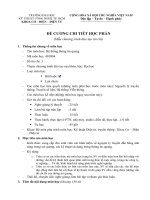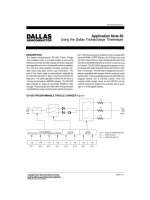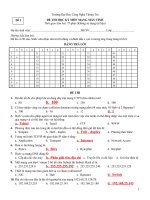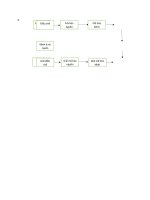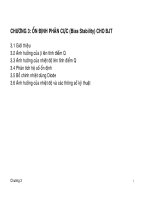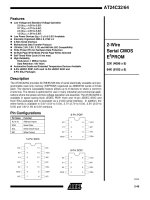Điện tử viễn thông lect02 1 khotailieu
Bạn đang xem bản rút gọn của tài liệu. Xem và tải ngay bản đầy đủ của tài liệu tại đây (459.71 KB, 35 trang )
2. Traffic
lect02.ppt
S-38.1145 - Introduction to Teletraffic Theory – Spring 2006
1
2. Traffic
Contents
•
•
•
•
Traffic characterisation
Telephone traffic modelling
Data traffic modelling at packet level
Data traffic modelling at flow level
2
2. Traffic
Offered vs. carried traffic
•
Offered traffic
– traffic as it is originally generated in the sources
•
Carried traffic
– traffic as it is carried by the network
3
2. Traffic
Characterisation of carried traffic
•
Circuit-switched traffic
– number of ongoing calls or active connections (erl)
– may be converted into bit rate in digital systems
• e.g. a telephone call reserves 64 kbps (= 8000*8 bps) in a PCM system
•
Packet-switched traffic
– bit stream (bps, kbps, Mbps, Gbps, …)
– packet stream (pps)
– number of active flows (erl)
4
2. Traffic
Traffic units
•
Telephone traffic:
– erlangs (erl)
– one erlang corresponds to one ongoing call or one occupied channel
•
Data traffic:
– bits per second (bps)
– packets per second (pps)
•
Note:
–
–
–
–
1 byte = 8 bits
1 kbps = 1 kbit/s = 1,000 bits per second
1 Mbps = 1 Mbit/s = 1,000,000 bits per second
1 Gbps = 1 Gbit/s = 1,000,000,000 bits per second
5
2. Traffic
Traffic variations in different time scales (1)
•
Predictive variations:
– Trend (years)
• traffic growth: due to
– existing services (new users, new ways to use, new tariffs)
– new services
– Regular year profile (months)
– Regular week profile (days)
– Regular day profile (hours)
• including “busy hour”
– Variations caused by predictive (regular and irregular) external events
• regular: e.g. Christmas day
• irregular: e.g. televoting
6
2. Traffic
Traffic variations in different time scales (2)
•
Non-predictive variations:
– Short term random variations (seconds - minutes)
• random call arrivals
• random call holding times
– Long term random variations (hours - ...)
• random deviations around the profiles
• each day, week, month, etc. is different
– Variations caused by non-predictive external events
• e.g. earthquakes and other natural disasters
•
Note:
– Ordinary traffic theoretic models focus on short term random variations
7
2. Traffic
Busy hour (1)
•
For dimensioning,
– an estimate of the traffic load is needed
•
In telephone networks,
– standard way is to use so called busy hour traffic for dimensioning
Busy hour ≈ the continuous 1-hour period for which the traffic volume is greatest
– This is unambiguous only for a single day (let’s call it daily peak hour)
– For dimensioning, however, we have to look at not only a single day but
many more
•
Different definitions for busy hour (covering several days) traffic have
been proposed by ITU:
• Average Daily Peak Hour (ADPH)
• Time Consistent Busy Hour (TCBH)
8
2. Traffic
Busy hour (2)
•
Let
–
–
–
•
N = number of days during which measurements are done (e.g. N = 10)
an(∆) = measured average traffic during 1-hour interval ∆ of day n
max∆ an(∆) = daily peak hour traffic of day n
Busy hour traffic a with different methods:
aADPH = 1 ∑ nN=1 max ∆ an ( ∆ )
N
aTCBH = max ∆ N1 ∑ nN=1 an ( ∆)
•
Note that
aTCBH ≤ aADPH
9
2. Traffic
Demo: Funet
•
Diurnal pattern, day profile
– day vs. night
– peak traffic, busy ”hour”
– changes in routing?
•
Week profile
– working days vs. weekend
•
Month profile
– special days: e.g. Christmas day
•
•
Year profile
Long-term trend?
/> />10
2. Traffic
Contents
•
•
•
•
Traffic characterisation
Telephone traffic modelling
Data traffic modelling at packet level
Data traffic modelling at flow level
11
2. Traffic
Traffic classification
Traffic
Circuit-switched
Packet-switched
e.g. telephone traffic
e.g. data traffic
Packet level
Flow level
e.g. IP
e.g. TCP, UDP
Elastic
Streaming
e.g. TCP
e.g. UDP
12
2. Traffic
Telephone network
•
Connection oriented:
B
– connections set up end-to-end
before information transfer
– resources reserved for the
whole duration of connection
– if resources are not available,
the call is blocked and lost
•
Information transfer as
continuous stream
A
13
2. Traffic
Telephone traffic model
•
Telephone traffic consists of calls
– a call occupies one channel from each of the links along its route
– call characterisation: holding time (in time units)
•
Modelling of offered traffic:
– call arrival process (at which moments new calls arrive)
– holding time distribution (how long they take)
•
Link model: a pure loss system
– a server corresponds to a channel
– the service rate µ depends on the average holding time
– the number of servers, n, depends on the link capacity
– when all channels are occupied, call admission control rejects new calls
so that they will be blocked and lost
•
Modelling of carried traffic:
– traffic process tells the number of ongoing calls = the number of occupied
channels
14
2. Traffic
Traffic process
channels
channel-by-channel
occupation
call holding time
6
5
4
3
2
1
time
nr of channels
call arrival times
nr of channels
occupied
blocked call
6
5
4
3
2
1
0
traffic volume
time
15
2. Traffic
Contents
•
•
•
•
Traffic characterisation
Telephone traffic modelling
Data traffic modelling at packet level
Data traffic modelling at flow level
16
2. Traffic
Traffic classification
Traffic
Circuit-switched
Packet-switched
e.g. telephone traffic
e.g. data traffic
Packet level
Flow level
e.g. IP
e.g. TCP, UDP
Elastic
Streaming
e.g. TCP
e.g. UDP
17
2. Traffic
Network layer in IP networks
IP = Internet Protocol
Connectionless:
– no connection establishment
– no resource reservations
•
•
Information transfer as discrete
packets
Best Effort service paradigm
– Network nodes (routers) forward
packets “as well as possible”
– Packets may be lost, delayed or
their order may change
⇒ “intelligence” should be
implemented at the edge nodes
or terminals
IP packet
IP header
Data
B
IP network
B
A
B
B
B
•
•
18
2. Traffic
Packet level model of data traffic
•
Data traffic consists of packets
– packets compete with each other for the processing and transmission
resources (statistical multiplexing)
– packet characterisation: length (in data units)
•
Modelling of offered traffic:
– packet arrival process (at which moments new packets arrive)
– packet length distribution (how long they are)
•
Link model: a single server queueing system
– the service rate µ depends on the link capacity and the average packet
length
– when the link is busy, new packets are buffered, if possible, otherwise they
are lost
•
Modelling of carried traffic:
– traffic process tells the number of packets in the system (including both
the packet in transmission and the packets waiting in the buffer)
19
2. Traffic
Packet level traffic process (1)
packet status (waiting/in transmission)
waiting time
transmission time
time
packet arrival times
number of packets in the system
4
3
2
1
0
time
link occupation
1
0
time
20
2. Traffic
Packet level traffic process (2)
link occupation (continuous)
C
time
link occupation (averaged)
C
time
21
2. Traffic
Contents
•
•
•
•
Traffic characterisation
Telephone traffic modelling
Data traffic modelling at packet level
Data traffic modelling at flow level
22
2. Traffic
Traffic classification
Traffic
Circuit-switched
Packet-switched
e.g. telephone traffic
e.g. data traffic
Packet level
Flow level
e.g. IP
e.g. TCP, UDP
Elastic
Streaming
e.g. TCP
e.g. UDP
23
2. Traffic
Transport layer in IP networks
•
On top of the network layer (IP) there is the transport layer
– takes care of handling the IP packets in the terminals
– operates end-to-end
•
Transport layer protocols:
– TCP = Transmission Control Protocol
• transmission rate adapts to traffic conditions in the network by a
congestion control mechanism
• suitable for non-real time (elastic) traffic, such as transfers of digital
documents (file transfer)
– UDP = User Datagram Protocol
• transmission rate independent of traffic conditions in the network
• suitable for transactions (interactive traffic with short transfers)
• used also for real time (streaming) traffic with the help of upper layer
protocols, such as RTP
24
2. Traffic
TCP
•
TCP = Transmission Control Protocol
– connection oriented end-to-end transmission layer protocol
– for a reliable byte stream transfer on top of IP
• the delivery of packets in the right order is checked using
acknowledgements and retransmissions
– Protocol specific flow and congestion control mechanisms for traffic control
• based on the use of an adaptive sliding window
– flow control: prevents over flooding the receiver
• the receiver tells who many bytes it can receive
– congestion control: prevents over flooding the network
• the transmitter has to find out when the network is congested
• a packet loss indicates congestion: when a packet is lost, the window
is decreased, otherwise gradually increased (to detect the network
state)
IP header
TCP header
Data
25
